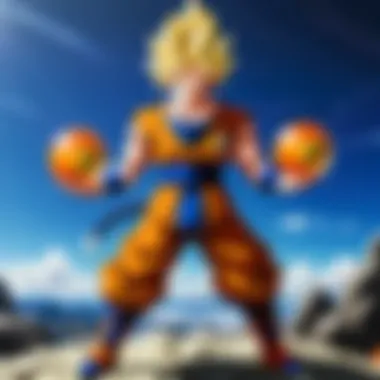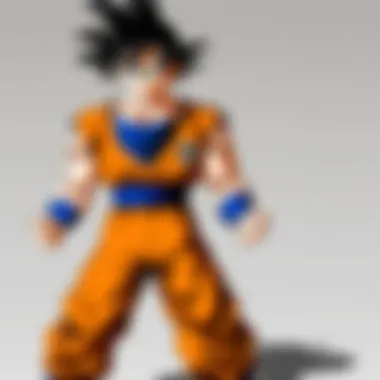Exploring the Legacy of Dragon Ball Z: A Deep Dive


Intro
The world of Dragon Ball Z is one that has captivated viewers for decades. Its intricate storytelling, diverse character arcs, and profound themes have etched a permanent mark on the landscape of anime. This exploration aims to clarify the depths of this series, examining key aspects such as its inception, character development, and lasting cultural resonance.
Creation and Development
The series began as a manga in 1984, crafted by Akira Toriyama. What started as a simple adventure story transformed into a cornerstone of the shōnen genre. The anime adaptation began in 1989, taking the world by storm with its unique blend of action, humor, and emotional depth. This format allowed for a larger audience, broadening the appeal of its main narrative.
Cultural Impact
Dragon Ball Z is not just an anime; it is a phenomenon that has influenced numerous creators and works worldwide. The show's concepts and characters have transcended cultural boundaries, integrating into the fabric of global anime culture. Elements like the principle of hard work, perseverance, and camaraderie resonate deeply with fans.
The comprehensive exploration of Dragon Ball Z will be structured to cover significant themes, key arcs, and the evolution of characters throughout the series. Readers will gain a nuanced understanding of why this series remains relevant and adored.
Episode Reviews
Summary of the Episode
Each episode of Dragon Ball Z introduces pivotal moments that mold the narrative. For instance, in the Frieza Saga, the battle on Namek is not just a visual spectacle; it is a context for character growth and ethical dilemmas faced by the Z fighters. Every episode contributes to the overarching theme of strength and sacrifice against formidable foes.
Analysis of Key Events
Dragon Ball Z consists of remarkable battles and deep storytelling. The transformation of characters into their various Super Saiyan forms serves as a representation of personal growth. The concept of pushing beyond one's limits is central to the entire series. Such transformations have become iconic, symbolizing hope, resilience, and the relentless pursuit of strength.
Discussion on Character Development
Character arcs in Dragon Ball Z are meticulously crafted. Goku, for instance, evolves from a naive child into a powerful hero, deeply motivated by his love for family and friends. Others, like Vegeta, have compelling redemption arcs that highlight the complexity of their pasts and motivations. Each character brings a unique perspective that captivates viewers, creating a rich tapestry of narratives.
Highlight Memorable Moments
Certain moments stand out, leaving an indelible impression on fans. Goku's legendary fight against Frieza, for example, represents a climax of tension and character resolution. This pivotal encounter blends action with deep emotional weight, capturing the essence of what Dragon Ball Z represents: the battle between good and evil, intertwined with personal growth.
“In order to be the champion, you must be prepared to be challenged.”
Character Spotlights
Background Information on the Character
Each character in Dragon Ball Z has a rich history that contributes to their development. For instance, Piccolo, originally an enemy of Goku, transforms into one of his closest allies. His journey exemplifies the themes of redemption and teamwork, showcasing how relationships can evolve through shared experiences.
Personality Traits and Unique Quirks
Every character possesses distinctive traits that make them memorable. Goku's cheerful demeanor contrasts sharply with Vegeta's prideful arrogance. These differences not only enhance interactions but also emphasize personal growth throughout the series.
Role in the Storyline
Characters like Bulma, though not fighters, are integral to the storyline. Their unique knowledge and skills often provide crucial assistance to the Z fighters, illustrating that strength comes in various forms. Focusing on these roles adds depth to the narrative.
Fan Theories and Speculations
The Dragon Ball Z community is rich with theories and speculations regarding character relationships and potential future developments. Fans often engage in discussions about hidden plots or character evolutions, adding layers to the series’ complexity.
Anime vs. Manga Comparison
Plot Differences Between the Anime and Manga
There are notable disparities between the Dragon Ball Z anime and its manga counterpart. While the anime expands on certain episodes through fillers, the manga maintains strict adherence to the core story. This difference often leads to varied fan experiences.
Art and Animation Quality
The art style and animation quality in both mediums have evolved. The series is celebrated for its fluid fight scenes and stylized character designs. However, the manga’s crisp illustrations often convey emotions in ways that sometimes get lost in animation.
Character Portrayal
Certain character portrayals differ between the two versions. For example, the anime offers deeper exploration of side characters through filler episodes, allowing for richer character exploration. In contrast, the manga keeps a tighter focus on the main narrative with fewer distractions.
Fan Preferences and Opinions
Fan opinions diverge widely on whether the manga or anime is superior. Each format has its strengths. Many prefer the disciplined storytelling of the manga, while others enjoy the immersive experience the anime provides.


Industry News and Updates
Announcements on Upcoming Releases
The Dragon Ball franchise continues to garner attention in the anime community. Recent announcements on upcoming films and series ensure that the legacy lives on, drawing in new generations of viewers.
Analysis of Industry Trends
The rise in interest for remastered and rebooted series has revitalized conversations around Dragon Ball Z. Observing how these trends influence fan engagement can reveal much about the anime industry.
Prolusion to Dragon Ball Z
Dragon Ball Z holds a critical place in the world of anime and manga. Its impact on popular culture is profound, with elements that resonate with audiences across generations. Understanding this series is essential for any anime enthusiast, as it offers more than just entertainment. It serves as a lens through which broader themes of heroism, friendship, and perseverance are examined.
Overview of the Series
Dragon Ball Z is the continuation of the original Dragon Ball series, which was created by Akira Toriyama. Premiering in Japan in 1989, it follows the adventures of Goku, a Saiyan warrior, as he protects Earth from various villains. The series is characterized by intense battles and character development, appealing to a broad audience.
The narrative expands on the foundation laid by its predecessor, introducing new characters and complex story arcs that delve into various aspects of combat and morality. The series captures the viewer's imagination through its unique blend of action, humor, and emotional depth.
Historical Context and Development
Dragon Ball Z was developed during a time when anime was becoming more accessible outside Japan. The late 1980s and early 1990s were pivotal for the anime industry, marked by a rise in international interest. The adaptation by Toei Animation played a key role in enhancing its global reach.
Additionally, the timing of its release coincided with other influential works, like Sailor Moon and Mobile Suit Gundam, reshaping how anime was perceived worldwide. This context provided fertile ground for Dragon Ball Z to flourish, making it not just a series but a cultural phenomenon. Through its rich history, it has influenced countless creators and continues to resonate.
"Dragon Ball Z is not merely a show; it is an experience that has shaped the narratives of many subsequent anime series."
Foundational Elements
The foundational elements of a series like Dragon Ball Z are crucial in understanding its success and lasting appeal. These elements not only shape the narrative and character arcs but also contribute to the overall engagement of the audience. The manga origins and its transition to anime highlight the roots of the series, while the contributions from various artists and writers provide insight into the creative decisions that have resonated with fans globally. Understanding these aspects allows for a deeper appreciation of the complexities involved in bringing Dragon Ball Z to life, and serves as a gateway to recognizing its cultural significance.
Manga Origins and Transition to Anime
Dragon Ball Z originated from a manga created by Akira Toriyama. This work first appeared in Weekly Shōnen Jump in 1984, establishing the groundwork for the Dragon Ball franchise. The manga’s success prompted For a transition to animation in 1989. This transition into anime was not just a shift in format but also a transformation in storytelling.
The anime introduced enhancements in terms of visual storytelling. The art style was adapted to suit the medium, with bright colors and fluid movements that complemented the high-energy battles. It allowed the narrative to expand beyond the manga, presenting additional scenes that enriched character development and plot depth. One pivotal aspect of this transition was the inclusion of filler episodes and arcs that, while not present in the original manga, provided fans with a broader view of the world and its inhabitants. This kind of storytelling helped in developing character backstories in a way that resonated with the audience.
Moreover, musical scores and voice acting brought an added layer of emotion to the narrative. The anime's opening and ending themes, composed by artists such as Chiho Moritaka, became iconic in their own right, further solidifying the series’ presence in pop culture. This combination of visuals, sound, and storytelling made Dragon Ball Z an exemplary model for future anime adaptations.
Key Contributors to the Series
The creation and success of Dragon Ball Z cannot be attributed to Akira Toriyama alone. A variety of key contributors played significant roles in shaping the series. Among them are:
- Akira Toriyama: The original creator of the Dragon Ball manga, Toriyama's unique art style and storytelling capabilities laid the foundation for the narrative.
- Toei Animation: This studio was responsible for producing the anime adaptation, contributing significantly to the character design, animation quality, and overall presentation of the series.
- Masako Nozawa: As the voice of Goku, Nozawa’s portrayal helped define the character, making him relatable and endearing to audiences.
- Kōhei Tanaka and Shunsuke Kikuchi: These composers crafted memorable music scores that accentuated pivotal moments in the story, enhancing emotional engagement.
In addition to these contributors, various writers and animators who worked on the show brought unique perspectives, ensuring that the series appealed to a broad audience. The collaboration among all these individuals created a rich tapestry of storytelling that continues to influence fans and creators alike.
"The collaborative effort behind Dragon Ball Z showcases how multiple talents can converge to achieve a shared vision, resulting in something greater than the sum of its parts."
Through these foundational elements, Dragon Ball Z established itself not just as a successful anime, but as a cultural phenomenon that resonates with both fans and new audiences around the world.
Character Analysis
The importance of character analysis in the context of Dragon Ball Z cannot be overstated. Characters serve as the backbone of any narrative, and in Dragon Ball Z, they are essential for the series’ emotional depth and complex storytelling. This section highlights significant aspects of the characters, such as their development, relationships, and their roles in conveying the larger themes of the series. Understanding these characters allows the audience to engage more fully with the story and its messages.
Protagonists: Goku and His Allies
Goku is the central character of Dragon Ball Z, embodying the qualities of determination and an unyielding spirit. His journey from an alien child to the protector of Earth showcases significant growth. Goku’s innocence and relentless pursuit of strength resonate with many fans. His allies, including Vegeta, Piccolo, and Gohan, enrich the narrative. Each ally has unique abilities and backstories that contribute to the dynamic of the series.
For instance, Vegeta begins as a ruthless antagonist but evolves into a key ally and complex character in his own right. His rivalry with Goku pushes both characters to new heights. The bond between these characters portrays themes of friendship, honor, and overcoming ego, allowing viewers to see how their relationships evolve throughout the series.
Antagonists: The Evolution of Villains
The antagonists in Dragon Ball Z are not merely obstacles; they are essential for developing the protagonists. Early villains like Raditz and Vegeta present challenges that force Goku and his allies to adapt and grow. As the series progresses, villains become more complex and relatable. For example, Frieza is often seen as one of the most malevolent forces in the universe, but his character also provides commentary on power and domination.
Cell is another significant antagonist, embodying themes of perfection and evolution. His character raises questions about identity and purpose, showcasing the more profound psychological aspects of antagonism.


Each villain introduces new dynamics and moral dilemmas, which makes their defeats also feel like significant triumphs. Through these conflicts, viewers explore concepts of good versus evil, and the consequences that come from reckless ambition.
Supporting Characters and Their Roles
Supporting characters in Dragon Ball Z play crucial roles that enrich the plot and deepen the themes. Characters like Bulma and Krillin provide the narrative with humor and humanity. They ground the more flamboyant aspects of the series, making it relatable.
Moreover, the presence of characters like Master Roshi and Tien adds diversity to the skillset within the group. They serve unique functions, from comic relief to wisdom. Their growth arcs often mirror that of the main characters, emphasizing themes of perseverance and mentorship.
The various supporting characters also illustrate how teamwork enhances strength. Their contributions reinforce the message that success is not solely dependent on the main hero but also on the collective effort of everyone involved. Through character interactions, Dragon Ball Z adeptly conveys the nuances of relationships, sacrifice, and personal growth.
Story Arcs Breakdown
In discussing Dragon Ball Z, the breakdown of its story arcs is crucial for a full understanding of its narrative structure and character development. Each arc presents unique challenges and reveals growth in both protagonists and antagonists. They contribute significantly to the overall plot and highlight the show's commitment to themes such as perseverance, camaraderie, and the struggle between good and evil. Importantly, analyzing these arcs helps fans appreciate how conflicts drive character transformations and narrative progression. The arcs create a progression that is engaging and systematically builds tension, leading to climactic battles and resolutions.
The Saiyan Saga
The Saiyan Saga serves as the gateway to the adventures in Dragon Ball Z. It introduces key characters like Vegeta and Nappa, who represent new levels of power and threat. This arc is integral because it marks a shift from Dragon Ball to Dragon Ball Z, signaling the deeper, more intense battles that characterize the series.
The resurrection of Goku’s past as a Saiyan opens discussions about his heritage. He faces the challenge of Saitans invading Earth, compelling him to transcend his limits. Here, a foundational rivalry develops between Goku and Vegeta, emphasizing the themes of competition and personal growth. This saga is essential in establishing the stakes and creating a sense of urgency that persists throughout the series.
The Frieza Saga
The Frieza Saga elevates tension to unparalleled heights. Frieza emerges as one of the most formidable villains, embodying cruelty and ambition. This arc primarily focuses on the conflict on Planet Namek and the pursuit of the Dragon Balls, which adds layers of intrigue to the narrative. Goku’s transformation into a Super Saiyan is a pivotal moment, symbolizing the culmination of his struggle and evolution.
The significance of this saga lies in its profound emotional impact and its commentary on vengeance and redemption. The intense confrontations lead to serious consequences, including character deaths and deep psychological scars. By pushing boundaries, the Frieza Saga reshapes the emotional landscape of the characters, making it a hallmark in the series.
The Cell Saga
In the Cell Saga, the narrative takes a darker turn as Androids and Cell present severe threats to the Earth. Here, the concept of perfection is explored, particularly through Cell's character, who seeks to absorb others to attain his ideal form. This arc introduces new and complex character dynamics, particularly the iconic moments involving Gohan.
Gohan’s ascension to power in this saga shifts the focus from Goku, highlighting the theme of potential and legacy. This transition showcases how growth does not always follow a predictable path. The stakes are incredibly high, and the emotional weight of the battles reveals vulnerabilities in the characters. The Cell Saga is a masterclass in suspense, ultimately reinforcing the importance of family and resilience.
The Buu Saga
The Buu Saga brings forth a unique antagonist in Majin Buu, who represents pure chaos and destruction. This arc diverges from previous themes of revenge and power. Instead, it emphasizes issues of forgiveness and the power of unity against overwhelming odds. The evolution of Buu from a malevolent force to a more benevolent entity underscores the complexities of character transformation.
In this saga, Goku faces the challenge of facing a foe who can regenerate and absorb opponents, creating a sense of hopelessness. The climax showcases teamwork among former enemies, reinforcing the strength found in alliances. The resolutions achieved highlight the power of hope and community, themes that resonate with the audience.
As each story arc unfolds, viewers witness the interplay of strength, character, and the consequences of choices that resonate far beyond individual battles.
Thematic Exploration
The thematic exploration of Dragon Ball Z underscores the series' significance on multiple levels. Understanding these themes illuminates why it resonates with viewers. Fundamental concepts such as heroism, sacrifice, friendship, rivalry, and redemption contribute to the depth of character interactions and narrative arcs. Additionally, these themes enhance the emotional potency of the series, making it relatable to diverse audiences.
The themes do not only shape the story; they also reflect societal values and philosophical inquiries. This section dissects the inherent messages of the show. Through specific examples, we can pinpoint how they manifest in the characters’ decisions and conflicts.
Heroism and Sacrifice
Heroism in Dragon Ball Z is often portrayed through the character of Goku. His relentless dedication to protect others showcases a traditional form of heroism. However, it is the theme of sacrifice that amplifies this portrayal. Characters often face dilemmas where they must choose between personal desires or the greater good. This adds layers to their motivations.
For instance, Goku's self-sacrifice against Frieza during the climactic battle illustrates heroism intertwined with a poignant sense of sacrifice. This event not only highlights his strengths but also his willingness to endure suffering for his friends and even enemies.
Key moments of sacrifice include:
- Goku’s transformation into a Super Saiyan
- Vegeta's noble sacrifice against Majin Buu
- Piccolo’s selfless act to save Gohan
By presenting these moments, Dragon Ball Z encapsulates the essence of what it means to be a true hero. The show challenges viewers to consider their own understanding of bravery and the costs associated with it.
Friendship and Rivalry
Friendship and rivalry serve as the backbone of many character relationships in Dragon Ball Z. The dynamic between Goku and Vegeta epitomizes how friendship can stem from rivalry. Initially, their relationship is marked by hatred and competition. As time progresses, mutual respect evolves, enriching the narrative. This evolution emphasizes how rivalry can lead to growth, not just for individuals but also as a unit.
The friendships portrayed are equally significant. They provide the emotional framework for many storylines, highlighting themes of loyalty, trust, and support. Examples include:
- Goku and Krillin's unwavering bond
- The camaraderie among the Z Fighters
- Bulma’s unwavering support for her friends
Through these interactions, the series introduces the idea that true strength is often derived from bonds with others. This theme resonates deeply and encourages the audience to reflect on the value of friendship in their own lives.


Redemption and Growth
Redemption is a recurring theme in Dragon Ball Z. Many characters embark on journeys of growth and transformation. The most notable examples include Piccolo and Vegeta. From antagonists, they evolve into allies, showcasing significant character development.
Their arcs demonstrate that redemption is possible and often requires significant personal struggle. This theme is compelling as it aligns with real-life experiences where individuals strive to better themselves.
The concept of growth is also tied to failure, as seen in Goku’s relentless training and tenacity to improve himself.
Here, Dragon Ball Z sends a vital message: everyone has the capacity for change, and every setback can be a stepping stone to success.
In summary, the thematic exploration within Dragon Ball Z enhances its complexity and relatability. By examining heroism and sacrifice, friendship and rivalry, along with redemption and growth, viewers gain a richer understanding of the characters and narratives. These themes contribute to the series' lasting impact and its ability to resonate with audiences worldwide.
Cultural Impact
Cultural impact plays a pivotal role in understanding the stature of Dragon Ball Z within the anime and manga domains. This series does not merely foster entertainment; it has shaped the identities and preferences of countless fans around the globe. As a cultural phenomenon, it evokes nostalgia, influences contemporary creators, and alters viewer expectations in ways that few other series have achieved. The analysis of its impact reveals a comprehensive picture of how Dragon Ball Z contributes to both the anime genre and the broader fabric of global pop culture.
Influence on Anime and Manga
Dragon Ball Z is often credited with redefining the anime landscape. Before its advent, anime was largely niche and confined to specific demographics. Its success paved the way for shonen anime. It laid the foundation for a style that emphasized prolonged action sequences, detailed world-building, and intricate character development.
Key characteristics that have influenced the industry include:
- Epic Battles: Long fight sequences with evolving power levels became a standard trope. This has been seen in series like Naruto and Bleach.
- Character Arcs: The importance of character growth and transformation has made its way into many modern narratives. Conflict, resolution, and redemption are deeply explored themes.
- Cultural Themes: Elements of mythology, friendship, and rivalry seen in Dragon Ball Z are echoed in countless other series, making them more relatable across different cultures.
The legacy of this series can also be traced through its global imitators, who adopt similar frameworks and narrative styles. Thus, Dragon Ball Z became a template for several genres, from action-adventure to comedic spin-offs.
Global Reception and Popularity
The response to Dragon Ball Z was immediate and significant. It transcended borders, reaching audiences in multiple countries and languages. This global reception has dimensions worthy of analysis:
- Television Adaptations: Airing worldwide, the series was adapted into various formats to accommodate local audiences. Subtitled and dubbed versions increased its accessibility.
- Merchandising Opportunities: Action figures, video games, clothing, and collectibles emerged as vital extensions of the series, contributing to its lasting presence in popular culture. Brands like Bandai and Toei Animation have capitalized on this fervor well beyond its initial broadcast.
- Fandom and Community: Online platforms, such as Reddit and Facebook, cultivate communities where enthusiasts share content, fan art, and theories. This continuous interaction strengthens the communal bonds among fans, personally connecting them to the series' legacy.
"The legacy of Dragon Ball Z is not merely in the stories told but in the connections forged between fans across the globe. Its influence ensures it occupies a permanent place in anime history."
Legacy and Continuation
The legacy of Dragon Ball Z is not only significant; it is pivotal in understanding the anime landscape. This section will detail the importance of this legacy, focusing on its cultural implications and the evolution of the franchise. As a cornerstone of anime history, Dragon Ball Z set a standard for storytelling, character development, and action sequences that many series have sought to replicate.
Dragon Ball Super and Beyond
Following the conclusion of Dragon Ball Z, the series continued with Dragon Ball Super, which reinvigorated the franchise and introduced new narratives and characters. This sequel series retained the essence of the original while exploring new content. Different arcs such as the Universe Tournament scrutinized the concept of strength and the dimensions of rivalry and friendship. The series also brought back beloved characters and introduced new ones, engaging both long-time fans and new viewers.
The writing team aimed to honor the legacy of Dragon Ball Z while pushing creative boundaries. As a result, Dragon Ball Super has not only maintained high ratings but has also expanded the series’ universe. The film Dragon Ball Super: Broly further explored the depth of Saiyan history, showcasing the important intersections of past and present, which kept fans invested.
Merchandising and Fan Culture
Merchandising has played a crucial role in the enduring appeal of Dragon Ball Z. From action figures to clothing and video games, the branding has saturated markets. This extensive range of products allows fans to engage with the franchise on multiple levels, making it a significant part of their lives.
Moreover, fan culture around Dragon Ball Z is vibrant and diverse. Conventions and online forums, such as those on Reddit, create spaces for enthusiasts to discuss theories, share fan art, and connect with like-minded individuals. This sense of community fosters a deeper appreciation for the series and helps sustain its relevance over decades. Even today, fans share their love for the series through social media platforms like Facebook, keeping the discussions alive and fresh.
"Dragon Ball Z is more than just a show; it’s a phenomenon that continues to evolve and inspire."
The combination of strong legacy and active fan engagement ensures that Dragon Ball Z remains a critical reference point in discussions about anime's past, present, and future.
Closure
The conclusion of this article serves to encapsulate the exploration of Dragon Ball Z and its multifaceted significance. It highlights the key elements addressed throughout the piece, reflecting on the series’ broad impact on both anime culture and its audiences.
Enduring Appeal of Dragon Ball Z
Dragon Ball Z continues to captivate fans even decades after its initial release. Its mixture of action, character development, and intricate plot lines has resonated across generations. The character of Goku remains a beacon of hope and determination, embodying the values of perseverance and friendship.
Fans are drawn to his journey and the relationships he builds with companions and rivals alike. The nostalgia factor plays a significant role here, as many viewers grew up watching the series and now share it with new audiences. Additionally, the series' thematic depth, touching on notions such as sacrifice, redemption, and the struggle between good and evil, resonates with fans on a personal level.
Moreover, the vast universe created by Akira Toriyama allows for endless exploration, including comics, movies, and games. The franchise also stays relevant through Dragon Ball Super, weaving old narratives into contemporary concerns. Its extensive merchandising and global community keep the passion alive, evident in the active discussions on platforms like Reddit.
Final Thoughts on Its Significance
In summary, Dragon Ball Z has left an indelible mark on the anime landscape. The series fundamentally changed how action anime is created and received. It pushed the boundaries of creativity, storytelling, and character development, setting a high bar for future series. The influence of Dragon Ball Z is observable across many genres, inspiring both creators and fans alike.
The cultural significance cannot be overstated. It has brought together a diverse and dedicated fan base while introducing complex themes that encourage reflection. Despite the evolution of the anime genre, the values instilled through Dragon Ball Z remain relevant in today's society.
The enduring appeal of Dragon Ball Z roots itself in its capacity to connect with audiences on multiple levels, ensuring its place in our hearts, minds, and popular culture.







